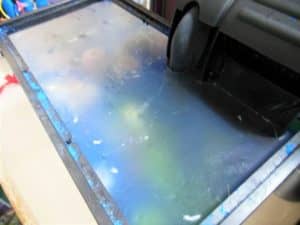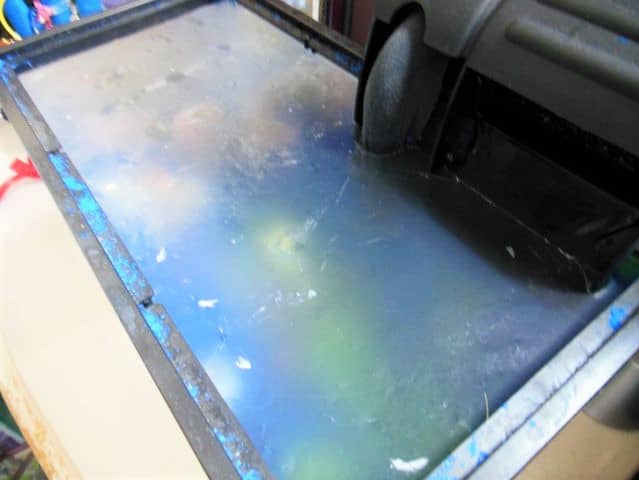The oil film is a natural phenomenon found in steady water. It comes from various sources such as Human hands, fish food, aquarium plants, fish poop, filter and pumps, dead fish, and fish tank location are some of the reasons why your fish tank produces oily film aquarium water.

What causes oily film in the aquarium? oily film on top
Jump To
- 1 What causes oily film in the aquarium? oily film on top
- 2 The below points will help you to understand the cause of the Oily Film Aquarium Water.
- 3 How do I get the oil film off my fish tank?
- 4 How do you Prevent oily film in an aquarium?
- 5 Fish Food: Proteins and oils from food
- 6 What is the film on top of my betta fish tank?
- 7 Related Questions
- 8 Conclusion:
There are various reasons why your aquarium is producing oil films in the water. The bottom of the fish tank may look normal, but as you reach the surface of the water, you will notice the shiny substance floating on the surface of the water. This is no other than the oil film produces by some of the elements in the water.
If you ignore the water body’s contamination due to extreme oil film, the oil layer will drastically grow and create a thick layer on the surface. The fish tank water would get less oxygen from the air. Also, excessive oil is harmful to fish. It may cause several diseases that are difficult to cure.
The below points will help you to understand the cause of the Oily Film Aquarium Water.
1) Human interaction with water:
There will be occasions when you have to keep your hands in the aquarium to manage some stuff in the water. Whether arranging the decorations, fixing the filter, removing the dead fish from the aquarium, or placing or removing plants, you have to dunk your hands in the water.
That is the most common reason why your tank has an oil film.
Your hand has pores in your skin. They produce a significant amount of oil and spill out every time. When you dunk your hand in the water, they get a release in the water and move on the surface. The oil film will be in the small portion that you will not notice it.
This oil slips from the hand and forms an oil slick in the aquarium. The only solution to avoid oil spills from your hands is to thoroughly wash your hand before you dunk them in the water. Do not put the hand in the water for longer than one minute. Oil from the body releases frequently.
Even if you wash your hand, the oil will get produced, and it will be mixed up in the water. Alternatively, buy a pair of aquarium-safe gloves. Wear them when you want to work in your tank.
2) Fish Food:
Every food contains a small or large amount of oil content. When you feed your fish, it gets dissolved in the water, and any fats or protein in food get released during the decaying process of the food. The oil floats to the surface of the aquarium, building the thick layer of the oil found in the fats.
Generally, the fish food gets dissolved in the water, which the fish do not eat. When you overfeed your fish, the leftover sinks in the water and reaches the bottom of the fish tank. Over the period the food molecules break down, and the excess oil is released, which goes to the top of the fish tank.
You cannot stop feeding oily food. All kinds of fish food would have protein content and various minerals that produce oil. So your fish tank will get some amount of oil.
3) Fish Poop:
Fish waste products are unavoidable. The more you feed the fish, the more poop it will produce that sinks to the bottom and breaks down over the period. The more oily food you feed to the fish, the oilier poop the fish tank would have that releases the oil in the water.
Additionally, the fish’s digestive system produces oils and proteins as they consume food. The excessive oil reaches the surface of the fish tank where it forms the oil slick.
4) Filters and Pumps:
If you recently purchased the filters or pumps, then they might produce a giant oil slick. Some filters have moving parts that need an oily substance to protect them from the two components’ traction.
The lubricated parts get in contact with the fish tank water, and the oil is released into the water creating the oil slick. Some oil would also be sticking on the filter’s surface that gets released into the water. Therefore, it is advisable to clean the filter and pumps before you place them in the aquarium.
5) Dead Fish -oil slick
When fish is dead, the body of the fish releases the fats and oils into the water. It breaks down the pieces, and the water smells bad. If you see the oil slick, then check for the dead fish in the water. Remove the dead fish before it starts decaying in the water.
6) Poor fish tank location
The tank location in the home is also determining how much exposure it gets from the atmosphere. We generally use various forms of home improvement products, air fresheners, and perfumes that move around the home with flowing air.
These products contain a high amount of oil substance. This substance will reach your fish tank creating a layer on the surface. Similarly, if the fish tank is located near the kitchen, the airborne oil would reach the tank through flowing air, and cooking air would form an oil slick. Choosing the right place for your aquarium would help you to reduce the oil slick in the water.

How do I get the oil film off my fish tank?
The fast way to clear the oil slick is to turn off the filters and pumps and wait for the water to become still. The oil can be extracted by placing a paper towel gently on the surface for a few moments, then wiping it. make sure to use a paper towel made of virgin paper pulp. It might be appropriate to replicate the procedure a couple of times. but if this does not solve the problem water change must be done.
How do you Prevent oily film in an aquarium?
Suppose you prevent the source of the oil from reaching the aquarium. Here are some of the ways you can get rid of the oily film in an aquarium.
Fish Food: Proteins and oils from food
Avoid food waste by breaking the feeding time and feeding the fish as much as they can eat. Dirty Hands: Use alternative ways when you are working in the aquarium. Less contact with the fish tank water would keep the oil away.
Oil in the Air:
Cooking oil gets spread in the air easily. You may have noticed your kitchen surface gets greasy over time. If your aquarium is in the same room then the cooking oil would spread in the room and it will reach to fish tank contaminating the aquarium water. Over time the oil layer will become thick and create an oil film in the water.
Equipment in the tank:
The filters, pumps, and other equipment used in the aquarium are lubricated. It would be best to wash them with soap and hot water before you place them in the aquarium. Clean them thoroughly.
Fish Waste Accumulation:
The proper filtration process and water regulator to avoid the water’s dirt would reduce the fish tank’s oil film chances.
Dead Fish:
The dead fish may produce a large number of oily substances in the water. You will notice as soon as the fish dies, the water at the surface looks oily. The decomposing of the fish body begins immediately, so before it fouls the water, remove it.
READ MORE Clean Aquarium Gravel With Or Without Vacuum Quick
What is the film on top of my betta fish tank?
The film is the Oil slick produced in the water that reaches the top of the water tank and creates a film. However, the film is not technically harmful to the fish. The excessive oil slick would block the water and reduce the oxygen level in the water. The top of the water surface consumes more oxygen than the bottom. So if your aquarium has an oil slick, then the water may have less oxygen for the fish.
You could need more pumps to produce oxygen in the water. It would be best if you replaced the small portion of the water to reduce the contaminated water. Take out the oil and pour the fresh water into the tank to ensure your fish gets the freshwater to breathe.
The process that creates oil slick: Organic Decay process in the aquarium
One of the problems with organic food is live food such as bloodworms, and plants have limited lives. When they die, they produce the organic oil that gets released into the water, and your aquarium would have the oil substance on the surface of the tank. Also, the leftover fish decay over time and contaminate the tank.
When the surface of the water does not move much or less water movement, the substance stays at the top covering the large area slowly. If you ignore it, the surface water of the tank will cover the entire tank. When you notice the water, it will have a sparkling oil slick that causes the water more difficult to breathe for the fish.
You can remove some of the films by drafting a paper towel in the water. The paper towel will soak the oil, and the majority of the oil will be removed. To prevent the oil slick from forming, you should increase the agitation that cleans the water naturally. Also, have a strong filtration process to clean a large portion of the water.
Related Questions
What is the oily film on top of aquarium water?
Yes, it is a biofilm, or called scum. Biofilm is commonly recognized as a transparent film of microorganisms or bacteria, formed on the surface of liquids but also of solids such as stones. This biofilm is also located on the aquarium surface of the water. This is a special area since it is effectively a boundary layer between air and water ecosystems.
Is biofilm bad for fish?
Biofilms (scum) are relatively harmless at the beginning. But if you let it develop for a long time, it can certainly do some harm. Biofilms can become a problem for aquariums, mainly because they absorb oxygen that would otherwise spread into the water. This can be particularly important for surface biofilm.
How to get rid of protein film in a fish tank
The film is caused by dissolved organics and can be corrected along with weekly 50-70 percent water changes and good filtration followed by daily surface agitation. You may want to look at having a surface skimmer as well (not a protein skimmer).
Conclusion:
Removing the oily film from the aquarium is easy when you know how to do it. Also, you can prevent it from forming using the above method.
READ MORE 15 Ways to Lower pH in Freshwater Aquarium.
READ MORE How Long Does Water Take to Dechlorinate ?
